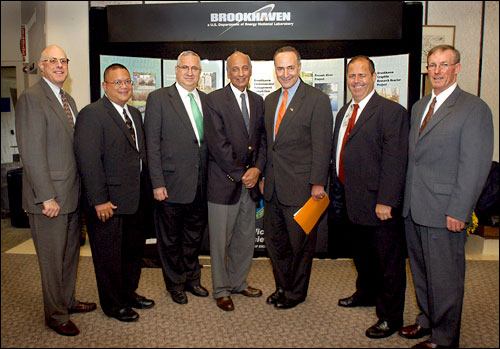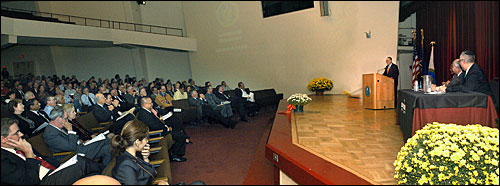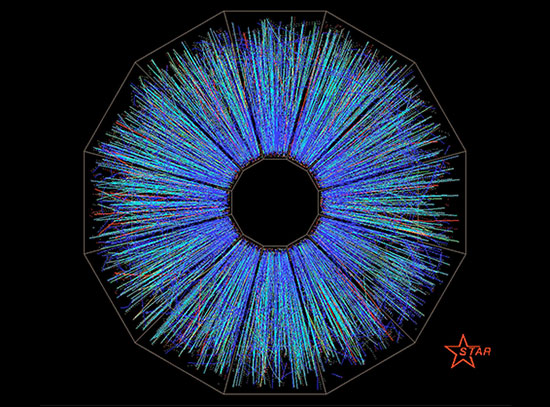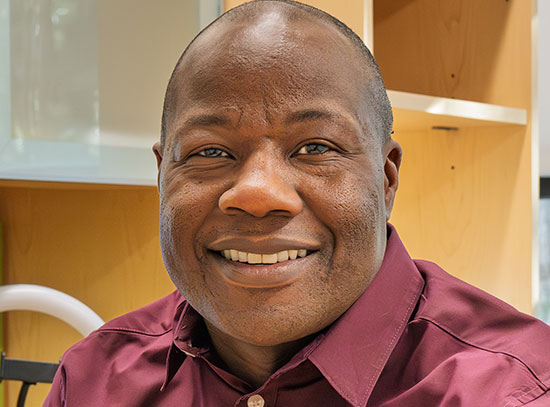Department of Energy, Brookhaven Lab, Regulators, Community Celebrate Completion of Lab Cleanup Projects
October 14, 2005
Note: The following press release has been jointly issued by the U.S. Department of Energy and Brookhaven National Lab. DOE contact: John Carter, 631 344-5195.
Upton, NY — The U.S. Department of Energy (DOE), Brookhaven National Laboratory management (the Lab), regulatory and elected officials, and community leaders today celebrated a momentous achievement: the completion of the high-priority environmental restoration work at and near the BNL site required in a 1992 agreement among DOE, the U.S. Environmental Protection Agency (EPA), and the N.Y. State Department of Environmental Conservation (DEC). The expansive scope of work includes all soil, groundwater, and Peconic River remediation projects, as well as several decommissioning projects at the Brookhaven Graphite Research Reactor.
 enlarge
enlarge
(L to R) William Levitan, Environmental Management, DOE, Rod Rimando, DOE project director for cleanup, Allen Steinberg, Regional Director, USEPA, Praveen Chaudhari, Director, Brookhaven National Lab, U.S. Senator Charles Schumer, Les Hill Director, Environmental Restoration Projects, and Michael Holland, Manager, DOE Brookhaven Site Office. (Click image to download hi-res version.)
"Through this public display of appreciation, we are recognizing all who made this accomplishment possible," said Rod Rimando, DOE project director for cleanup at the BNL site. "We greatly improved the quality of Brookhaven National Laboratory's natural environment and its surrounding areas; of that we are proud. As a good neighbor on Long Island, we continually strive for a cleaner environment, and will assure it through our pollution prevention, waste minimization and environmental protection programs," he added.
To reach this point, the Department of Energy and the Lab worked closely with regulatory agencies, and gained the support of the community by establishing a practice of openly sharing information, soliciting extensive input on cleanup decisions, and giving real-time feedback on how that input was used. By cooperating with the community, regulatory agency staff, and elected officials on each project, DOE and the Lab determined the extent of the various areas of contamination, developed plans on how best to address them, and turned those plans into actions.
"I was pleased to secure extra funding so this cleanup could be completed as expeditiously as possible," said U.S. Senator Charles Schumer. "Brookhaven Lab is a vital scientific and economic resource, not only for Long Island, but also N.Y. State and the nation. I'm proud of the accomplishments we're celebrating today."
Over the past 13 years, the cleanup program has:
- Invested $353 million and 2.65 million person-hours in restoring the Brookhaven National Laboratory site
- Constructed and operated 16 groundwater treatment systems on and off the site
- Cleaned more than eight billion gallons of groundwater
- Removed more than 5,000 pounds of chemical contaminants from the aquifer
- Installed 3,000 groundwater monitoring wells and analyzed thousands of samples
- Restored the Peconic River, an environmental, cultural, and recreational resource
- Excavated/disposed more than 55,000 cubic yards of contaminated soil and debris
- Completed several major decommissioning projects at the Lab's graphite reactor
(L to R) Rod Rimando, Congressman Timothy Bishop, and Michael Holland. (Click image to download hi-res version.)
All of the work was funded by DOE and done with the oversight of and in cooperation with the EPA and DEC. In 1992, DOE entered into a formal tri-party interagency agreement under which the three agencies would guide all aspects of the investigation and cleanup process.
"EPA participated with the state and county in overseeing the cleanup work at Brookhaven Lab, and today we have reached a milestone," said EPA Regional Administrator Alan J. Steinberg. "This is a good example of what can happen when different organizations come together with the common goal of protecting the people's health and the environment."
The N.Y. State Department of Health and Suffolk County Departments of Health Services and Parks also played key roles.
"The County of Suffolk is satisfied with DOE's and BNL's efforts over the last decade to address concerns for the health of area residents," said County Executive Steve Levy. "Groundwater remediation, the extension of public water mains, and the Lab's more recent efforts in cleaning up the Peconic River have gone a long way in allaying these concerns. We look forward to continuing our work with DOE and the Lab in planning the decommissioning of the graphite and high flux beam reactors," Levy said.
History
Brookhaven was placed on the EPA's National Priorities List in 1989 due to known groundwater and soil contamination at the site from historical practices. The entire cleanup proceeded under the rigorous process set by the federal Comprehensive Environmental Response, Compensation and Liability Act of 1980.
Initial cleanup efforts focused on removing known sources of contamination (to prevent additional contaminants from getting into groundwater) and installing boundary groundwater treatment systems (to prevent additional groundwater contamination from moving off site). As a precautionary measure, more than 1,500 homes south and east of the Lab were connected to the public water supply beginning in 1996.
At the same time, the Lab was re-writing its procedures, processes and monitoring plans to ensure that the environmental mistakes of the past could not happen again.
This strategy of addressing immediate concerns gave the Lab and DOE time to complete a comprehensive investigation of groundwater and soil on and off site, as well as sediments in the Peconic River. Following extensive sampling and analysis of groundwater, soil and sediment, the Lab and DOE were able to construct a detailed "picture" of the extent of contamination, set priorities and move forward with dozens of significant cleanup projects. Gallon-by-gallon, shovel-by-shovel, system-by-system, and project-by-project, incremental but progressive achievements were made. The culmination of those efforts is the milestone being celebrated today.
"The environmental program has been a priority at the Laboratory for many years, and the support we've received from the Department of Energy helped make these accomplishments possible," said Laboratory Director Praveen Chaudhari. "I was also pleased to see so many in the broader community take a keen and positive interest in making this program a success."
Future
Now that the high priority cleanup is complete, what remains is long-term treatment of groundwater, continued monitoring, and regular reviews to ensure the cleanup remedies remain effective. In addition, the decommissioning of the graphite reactor will be completed in 2007, and planning for the future decommissioning of the High Flux Beam Reactor is moving forward.
Past operations at the Laboratory have resulted in environmental contamination dating back to the early 1940s when it was Camp Upton, a U.S. Army base. In 1947, the U.S. War Department transferred Camp Upton to the U.S. Atomic Energy Commission (AEC), which was the predecessor agency to the present DOE. The DOE continues to fund cleanup and will until such time the Lab is completely restored and removed from the EPA's National Priorities List. Today, Brookhaven Lab is one of ten national laboratories managed by DOE's Office of Science and dedicated to leading-edge research.
2005-10383 | INT/EXT | Newsroom











